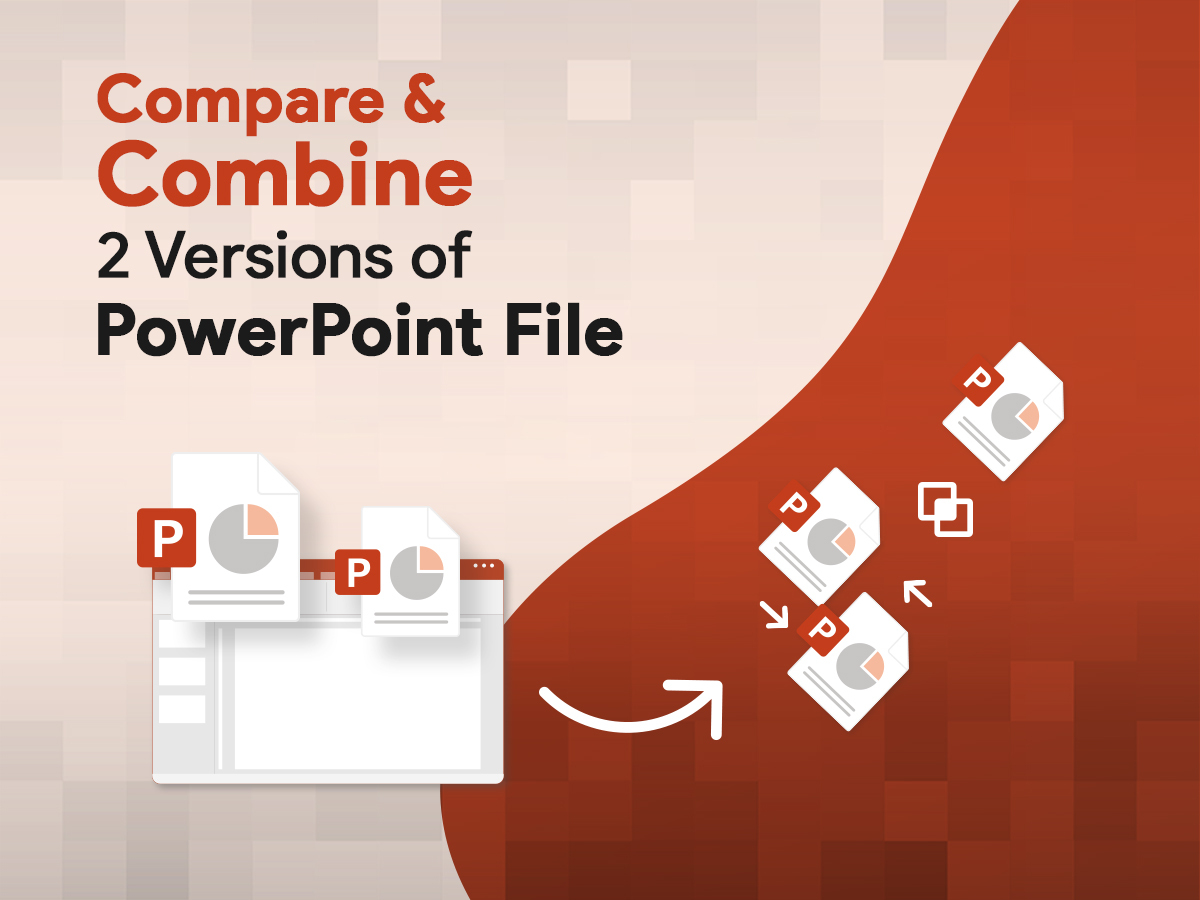How to Compare and Combine Two Versions of a PowerPoint File?

When you work with a team, you will often have to accommodate feedback and changes suggested by everyone in the team. The real problem is to collate all the suggestions and implement them in a single PowerPoint presentation. Often, people will have different ways of giving feedback. Combining all the opinions from different people marked across multiple presentations might seem like an effortful task. But, PowerPoint has features and established techniques to compare and combine two versions of files with ease. You can compare PowerPoint files, and combine 2 versions of a PPT file into one. Want to find out how? Read on.
Table of contents
- An example (for context)
- How to compare two versions of a PowerPoint file
- Step 1: Save the reviewer’s PowerPoint presentation version
- Step 2: Open a version
- Step 3: Head over to the Review tab
- Step 4: Compare two PowerPoint files
- Step 5: Combine PowerPoint presentations
- Can you compare two versions of pictures on PowerPoint?
- Can you compare two versions of animations on PowerPoint?
- Can you compare transitions on PowerPoint?
- Conclusion
An example (for context)
Suppose you have the original version of your PowerPoint presentation named Version 1 and the one where one of your team members/reviewer make edits as Version 2. Here are the differences between both the versions:
Version 1:
It has a sentence along with an image.
Version 2:
The reviewer edited the spelling of a word from the sentence since it was misspelled and added an additional image towards the right side of the existing image.
We know the changes in this example can be manually spotted and corrected, but, we are using such an easy one to simply demonstrate the comparing and combining process.
How to compare two versions of a PowerPoint file?
Step 1: Save the reviewer’s PowerPoint presentation version
The very first step to compare and combine two versions of a PowerPoint file is to download the reviewer’s PowerPoint presentation version. Once, you have done that, ensure you have the two versions of the file named in an easy-to-distinguish manner. Basically, both your version and the reviewer’s version should be identifiable with just a glance.
Step 2: Open a version
Now, it’s time to open the version on which you are comfortable accommodating all the changes. If you feel like making all the changes to your original file, open that particular version.
Step 3: Head over to the Review tab
Once that’s done, head over to the Review tab toward the right-hand side of the PowerPoint ribbon, and click on Compare function.

This action will lead to a browse window popping up on the screen. Simply, identify and select the reviewed version of your presentation and click on Merge.
Now, you will be able to see all the comments and changes from the two versions, all in one place.
Step 4: Compare two PowerPoint files
Now, it’s time to look for changes. Upon completion of the previous step, you will get back to the PowerPoint file you had opened with an additional Revisions pane on the right-hand side of the slide along with some annotations on the slides.

The Revisions pane has two parts – Slide Changes and Presentation Changes. As their name suggests, the former is where the comments can be seen and the latter is where the edits within the presentation can be seen. When you click on each list item from the Revisions pane, you will see the details about a change in the body of the slide. So, you can either go slide-by-slide with the edits or just follow the Revisions pane to compare.
From the example mentioned in the beginning of the article, the changes made on Version 2 will appear on the presentation as comments and annotations. This includes the spelling changes, and the image addition.
How to Merge Two PowerPoint Presentations
Step 5: Combine PowerPoint presentations
You would be wondering how to merge the two PowerPoint presentations now. It’s quite simple. You can straightaway apply all the changes by clicking on the Accept button placed next to the Compare button. The dropdown menu that appears after this will give you two options – Accept All Changes to This Slide and Accept All Changes to the Presentation.

Here, one will let you apply the changes just to a single slide and the other will let you apply all the changes across the presentation. Similarly, you can use the Reject button to reject all the changes on an individual slide or all across the presentation.
The same process goes for comments as well. You can remove comments by clicking on the Delete button from the Comments group. The dropdown menu that appears after this will give you two options – one for deleting the comments from that particular slide and the other for deleting the comments all across the presentation.

The last two paragraphs mentioned about applying or rejecting all the changes in one go. But, in reality, you may not be interested in bulk accepting or rejecting changes and comments. While you perform the revisions, you will see yellow checkboxes against each change next to the Other authors. You can use the checkboxes to accept/reject a change or see what it consists of. Leave the checkbox untouched to accept the change and untick it to reject the change.
Once you are done with all the comments and changes, click on End Review on PowerPoint’s ribbon.
This ends the complete process. Now, you know how to compare PowerPoint presentations files and how to combine PowerPoints for a polished end product.
Can you compare two versions of pictures on PowerPoint?
Yes, you can compare two versions of pictures on PowerPoint. The Revisions pane will let you know if any of your pictures have been moved and/or resized. It will also alert you if additional images have been added or older ones been deleted.
Can you compare two versions of animations on PowerPoint?
No, you can’t compare two versions of animations on PowerPoint. PowerPoint will alert you telling that there is a “Non-mergeable content: Animations”. It will only let you bulk accept or bulk reject all changes on the slide, rather than choosing them one at a time.
Can you compare transitions on PowerPoint?
Yes. You will see transition comparisons easily if you use the Details section of the revisions pane that indicates it using an icon to the side of the slide itself.
Conclusion
Besides using the compare feature on PowerPoint to compare and combine presentations, you can ask or educate your team members to use the New Comment button on the review tab, or use coloured rectangular boxes to write their suggestions.


